Investigation on the Power Factor of Skutterudite Smy(FexNi1−x)4Sb12 Thin Films: Effects of Deposition and Annealing Temperature
Abstract
:1. Introduction
2. Materials and Methods
2.1. Preparation of Porous Samples and Dense Targets
2.2. Characterization of Porous Samples and Dense Targets
2.3. Deposition of Thin Films
2.4. Characterization of Thin Films
3. Results and Discussion
3.1. Morphological, Compositional and Structural Properties of Porous and Dense Samples
3.2. Morphological, Structural and Transport Properties of Thin Films
4. Conclusions
Author Contributions
Funding
Institutional Review Board Statement
Informed Consent Statement
Data Availability Statement
Acknowledgments
Conflicts of Interest
Appendix A
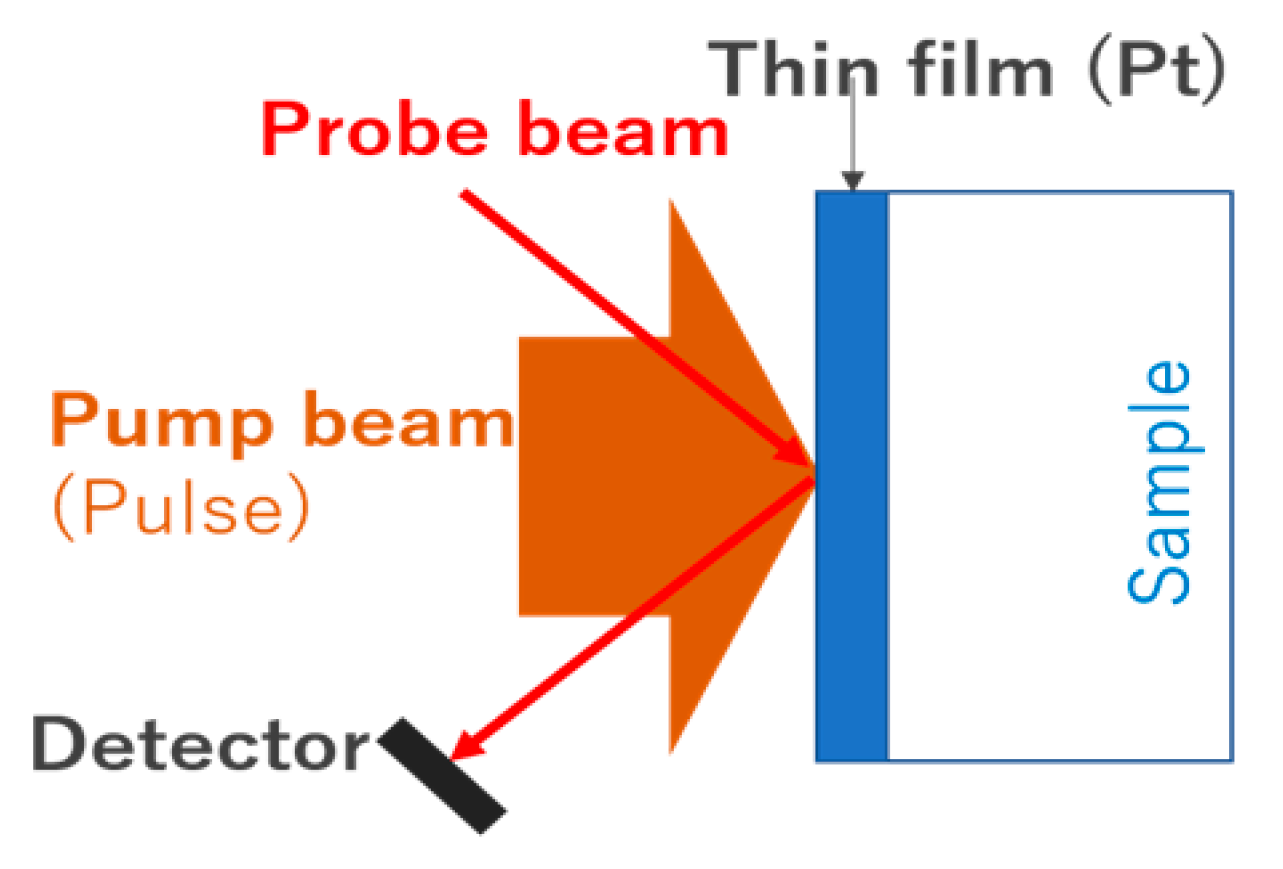
| Sample | Heat Diffusion Time | Thermal Effusivity | Thermal Conductivity | |
|---|---|---|---|---|
| Fe63_ann | 55.5 × 10−10 | 0.747 | 1757 | 1.91 |
| Fe70_ann | 6.21 × 10−10 | 0.717 | 1890 | 2.21 |

References
- Şen, Z. Solar energy in progress and future research trends. Prog. Energy Combust. Sci. 2004, 30, 367–416. [Google Scholar] [CrossRef]
- Zerrahn, A. Wind Power and Externalities. Ecol. Econ. 2017, 141, 245–260. [Google Scholar] [CrossRef]
- Ma, S.; Lin, M.; Lin, T.-E.; Lan, T.; Liao, X.; Maréchal, F.; Van Herle, J.; Yang, Y.; Dong, C.; Wang, L. Fuel cell-battery hybrid systems for mobility and off-grid applications: A review. Renew. Sust. Energ. Rev. 2021, 135, 110119. [Google Scholar] [CrossRef]
- Artini, C. RE-doped ceria systems and their performance as solid electrolytes: A puzzling tangle of structural issues at the average and local scale. Inorg. Chem. 2018, 57, 13047–13062. [Google Scholar] [CrossRef] [PubMed] [Green Version]
- Cózar, I.R.; Pujol, T.; Massaguer, E.; Massaguer, A.; Montoro, L.; Gonzàlez, J.R.; Comamala, M.; Ezzitouni, S. Effects of module spatial distribution on the energy efficiency and electrical output of automotive thermoelectric generators. Energies 2021, 14, 2232. [Google Scholar] [CrossRef]
- Zoui, M.A.; Bentouba, S.; Stocholm, J.G.; Bourouis, M. A review on thermoelectric generators: Progress and applications. Energies 2020, 13, 3606. [Google Scholar] [CrossRef]
- Petsagkourakis, I.; Tybrandt, K.; Crispin, X.; Ohkubo, I.; Satoh, N.; Mori, T. Thermoelectric materials and applications for energy harvesting power generation. Sci. Technol. Adv. Mater. 2018, 19, 836–862. [Google Scholar] [CrossRef]
- Haras, M.; Skotnicki, T. Thermoelectricity for IoT—A review. Nano Energy 2018, 54, 461–476. [Google Scholar] [CrossRef]
- Tarancon, A. Powering the IoT revolution with heat. Nat. Electron. 2019, 2, 270–271. [Google Scholar] [CrossRef]
- Nandihalli, N.; Liu, C.J.; Mori, T. Polymer based thermoelectric nanocomposite materials and devices: Fabrication and characteristics. Nano Energy 2020, 78, 105186. [Google Scholar] [CrossRef]
- Slack, G.A. New Materials and Performance Limits for Thermoelectric Cooling. In CRC Handbook of Thermoelectrics, 1st ed.; Rowe, D.M., Ed.; Taylor and Francis: Boca Raton, FL, USA, 1995; pp. 407–439. [Google Scholar]
- Li, Y.; Qiu, P.; Duan, H.; Chen, J.; Snyder, G.J.; Shi, X.; Brummerstedt Iversen, B.; Chen, L. Enhanced thermoelectric performance in rare earth-filled skutterudites. J. Mater. Chem. C 2016, 4, 4374–4379. [Google Scholar] [CrossRef]
- Khan, A.U.; Kobayashi, K.; Tan, D.-M.; Yamauchi, Y.; Hasegawa, K.; Mitome, M.; Xue, Y.; Jiang, B.; Tsuchiya, K.; Golberg, D.; et al. Nano-micro porous skutterudites with 100% enhancement in ZT for high performance thermoelectricity. Nano Energy 2017, 31, 152–159. [Google Scholar] [CrossRef]
- Rogl, G.; Rogl, P. Skutterudites, a most promising group of thermoelectric materials. Curr. Opin. Green Sust. Chem. 2017, 4, 50–57. [Google Scholar] [CrossRef]
- Benyahia, M.; Ohorodniichuk, V.; Leroy, E.; Dauscher, A.; Lenoir, B.; Alleno, E. High thermoelectric figure of merit in mesostructured In0.25Co4Sb12 n-type skutterudite. J. Alloys Compd. 2018, 735, 1096–1104. [Google Scholar] [CrossRef]
- Rogl, G.; Rogl, P. How nanoparticles can change the figure of merit, ZT, and mechanical properties of skutterudites. Mater. Today Phys. 2017, 3, 48–69. [Google Scholar] [CrossRef]
- Snyder, G.J.; Toberer, E.S. Complex Thermoelectric Materials. Nat. Mater. 2008, 7, 105–114. [Google Scholar] [CrossRef]
- Chen, S.; Ren, Z. Recent progress of half-Heusler for moderate temperature thermoelectric applications. Mater. Today 2013, 16, 387–395. [Google Scholar] [CrossRef]
- Dolyniuk, J.A.; Owens-Baird, B.; Wang, J.; Zaikina, J.V.; Kovnir, K. Clathrate thermoelectrics. Mater. Sci. Eng. R 2016, 108, 1–46. [Google Scholar] [CrossRef] [Green Version]
- Artini, C.; Fanciulli, C.; Zanicchi, G.; Costa, G.A.; Carlini, R. Thermal expansion and high temperature structural features of the filled skutterudite Smβ(FeαNi1−α)4Sb12. Intermetallics 2017, 87, 31–37. [Google Scholar] [CrossRef]
- Sales, B.C. Filled skutterudites. In Handbook on the Physics and Chemistry of Rare Earths, 1st ed.; Gschneidner, K.A., Jr., Bünzli, J.-C.G., Pecharsky, V.K., Eds.; North Holland: Amsterdam, The Netherlands, 2003; Volume 33, pp. 1–34. [Google Scholar]
- Uher, C. Skutterudite-Based Thermoelectrics. In Thermoelectrics Handbook—Macro to Nano, 1st ed.; Rowe, D.M., Ed.; Taylor and Francis: Boca Raton, FL, USA, 2005; Chapter 34; pp. 1–17. [Google Scholar]
- Uher, C. In search of efficient n-type skutterudite thermoelectrics. In Proceedings of the 21st Conference on Thermoelectrics, Long Beach, CA, USA, 29 August 2002; IEEE: Long Beach, CA, USA, 2002; pp. 35–41. [Google Scholar]
- Keppens, V.; Mandrus, D.; Sales, B.C.; Chakoumakos, B.C.; Dai, P.; Coldea, R.; Maple, M.B.; Gajewski, D.A.; Freeman, E.J.; Bennington, S. Localized vibrational modes in metallic solids. Nature 1998, 395, 876–878. [Google Scholar] [CrossRef]
- Rogl, G.; Grytsiv, A.; Rogl, P.; Peranio, N.; Bauer, E.; Zehetbauer, M.; Eibl, O. n-Type skutterudites (R,Ba,Yb)yCo4Sb12 (R = Sr, La, Mm, DD, SrMm, SrDD) approaching ZT ≈ 2.0. Acta Materalia 2014, 63, 30–43. [Google Scholar] [CrossRef]
- Rogl, G.; Renk, O.; Ghosh, S.; Mallik, R.C.; Grytsiv, A.; Bursik, J.; Schafler, E.; Tuomisto, F.; Bauer, E.; Rogl, P. Properties of HPT-Processed Large Bulks of p-Type Skutterudite DD0.7Fe3CoSb12 with ZT > 1.3. ACS Appl. Energy Mater. 2021, 4, 4831–4844. [Google Scholar] [CrossRef]
- Artini, C.; Carlini, R.; Spotorno, R.; Failamani, F.; Mori, T.; Mele, P. Structural properties and thermoelectric performance of the double filled skutterudite (Sm,Gd)y(FexNi1−x)4Sb12. Materials 2019, 12, 2451. [Google Scholar] [CrossRef] [PubMed] [Green Version]
- Artini, C.; Zanicchi, G.; Costa, G.A.; Carnasciali, M.M.; Fanciulli, C.; Carlini, R. Correlations between structural and electronic properties in the filled skutterudite Smy(FexNi1–x)4Sb12. Inorg. Chem. 2016, 55, 2574–2583. [Google Scholar] [CrossRef] [PubMed]
- Rogl, G.; Grytsiv, A.; Heinrich, P.; Bauer, E.; Kumar, P.; Peranio, N.; Eibl, O.; Horky, J.; Zehetbauer, M.; Rogl, P. New bulk p-type skutterudites DD0.7Fe2.7Co1.3Sb12−xXx (X = Ge, Sn) reaching ZT > 1.3. Acta Mater. 2015, 91, 227–238. [Google Scholar] [CrossRef] [Green Version]
- Rogl, G.; Grytsiv, A.; Bauer, E.; Rogl, P.; Zehetbauer, M. Thermoelectric properties of novel skutterudites with didymium: DDy(Fe1−xCox)4Sb12 and DDy(Fe1−xNix)4Sb12. Intermetallics 2010, 18, 57–64. [Google Scholar] [CrossRef]
- Artini, C.; Carlini, R.; Gigli, L.; Fanciulli, C. Compositional optimization and structural properties of the filled skutterudite Smy(FexNi1−x)4Sb11.5Sn0.5. Metals 2020, 10, 692. [Google Scholar] [CrossRef]
- Shaheen, N.; Sufyan Javed, M.; Ullah Shah, H.; Hussain, S.; Ashfaq Ahmad, M.; Raza, R.; Saleem, M.; Zhou, X. Enhanced thermoelectric properties in Ge-doped and single-filled skutterudites prepared by unique melt-spinning method. Ceram. Int. 2018, 44, 12610–12614. [Google Scholar] [CrossRef]
- Liang, G.-X.; Zheng, Z.-H.; Li, F.; Luo, J.-T.; Jin, H.; Zhang, X.-H.; Fan, P. Nano structure Ti-doped skutterudite CoSb3 thin films through layer inter-diffusion for enhanced thermoelectric properties. J. Eur. Ceram. Soc. 2019, 39, 4842–4849. [Google Scholar] [CrossRef]
- Fu, G.; Zuo, L.; Chen, J.; Lu, M.; Yu, L. Thermoelectric properties of DC-sputtered filled skutterudite thin film. J. Appl. Phys. 2015, 117, 125304. [Google Scholar] [CrossRef] [Green Version]
- Daniel, M.V.; Lindorf, M.; Albrecht, M. Thermoelectric properties of skutterudite CoSb3 thin films. J. Appl. Phys. 2016, 120, 125306. [Google Scholar] [CrossRef]
- Zheng, Z.-H.; Li, F.; Luo, J.-T.; Liang, G.-X.; Ma, H.-L.; Zhang, X.-H.; Fan, P. Thermoelectric properties and micro-structure characteristics of nano-sized CoSb3 thin films prefabricating by co-sputtering. J. Alloys Compd. 2018, 732, 958–962. [Google Scholar] [CrossRef]
- Bourgès, C.; Sato, N.; Baba, T.; Baba, T.; Ohkubo, I.; Tsujii, N.; Mori, T. Drastic power factor improvement by Te doping of rare earth-free CoSb3-skutterudite thin films. RSC Adv. 2020, 10, 21129–21135. [Google Scholar] [CrossRef]
- Colceag, D.; dauscher, A.; Lenoir, B.; da Ros, V.; Birjega, R.; Moldovan, A.; Dinescu, M. Pulsed laser deposition of doped skutterudite thin films. Appl. Surf. Sci. 2007, 253, 8097–8101. [Google Scholar] [CrossRef]
- Artini, C.; Cingolani, A.; Valenza, F.; Anselmi-Tamburini, U.; Latronico, G.; Mele, P. Effect of the sintering pressure on structure and microstructure of the filled skutterudite Smy(FexNi1-x)4Sb12 (x = 0.50–0.80, y = 0.17–0.55). Mater. Res. Bull. 2021, 139, 111261. [Google Scholar] [CrossRef]
- Weast, R.C. Handbook of Chemistry and Physics, 56th ed.; CRC Press: Cleveland, OH, USA, 1975. [Google Scholar]
- Kakefuda, Y.; Yubuta, K.; Shishido, T.; Yoshikawa, A.; Okada, S.; Ogino, H.; Kawamoto, N.; Baba, T.; Mori, T. Thermal conductivity of PrRh4.8B2, a layered boride compound. APL Mater. 2017, 5, 126103. [Google Scholar] [CrossRef]
- Piotrowski, M.; Franco, M.; Sousa, V.; Rodrigues, J.; Deepak, F.L.; Kakefuda, Y.; Baba, T.; Kawamoto, N.; Owens-Baird, B.; Alpuim, P.; et al. Probing of thermal transport in 50 nm Thick PbTe nanocrystal films by time-domain thermoreflectance. J. Phys. Chem. C 2018, 122, 27127–27134. [Google Scholar] [CrossRef] [Green Version]
- Daou, R.; Pawula, F.; Lebedev, O.; Berthebaud, D.; Hebert, S.; Maignan, A.; Kakefuda, Y.; Mori, T. Anisotropic thermal transport in magnetic intercalates FexTiS2. Phys. Rev. B. 2019, 99, 085422. [Google Scholar]
- Gao, W.; Liu, Z.; Baba, T.; Guo, Q.; Tang, D.M.; Kawamoto, N.; Bauer, E.; Tsujii, N.; Mori, T. Significant off-stoichiometry effect leading to the N-type conduction and ferromagnetic properties in titanium doped Fe2Val thin films. Acta Materialia 2020, 200, 848–856. [Google Scholar] [CrossRef]
- Artini, C.; Castellero, A.; Baricco, M.; Buscaglia, M.T.; Carlini, R. Structure, microstructure and microhardness of rapidly solidified Smy(FexNi1−x)4Sb12 (x = 0.45, 0.50, 0.70, 1) thermoelectric compounds. Solid State Sci. 2018, 79, 71–78. [Google Scholar] [CrossRef]
- Mustoufa, S.; Tsuyuguchi, S.; Arashi, T.; Nishida, M.; Hino, T. Formation of Droplets on Thin Film Surface in Pulsed Laser Deposition Using Metal Targets. Q. J. Jpn. Weld. Soc. 2003, 21, 338–343. [Google Scholar]
- Carlini, R.; Khan, A.U.; Ricciardi, R.; Mori, T.; Zanicchi, G. Synthesis, characterization and thermoelectric properties of Sm filled Fe4−xNixSb12. J. Alloys Compd. 2016, 655, 321–326. [Google Scholar] [CrossRef]
- Zheng, Z.H.; Wei, M.; Luo, J.T.; Li, F.; Liang, G.X.; Liang, Y.; Hao, J.; Ma, H.L.; Zhang, X.H.; Fan, P. An enhanced power factor via multilayer growth of Ag-doped skutterudite CoSb3 thin films. Inorg. Chem. Front. 2018, 5, 1409–1414. [Google Scholar] [CrossRef] [Green Version]
- Baba, T. Analysis of One-dimensional Heat Diffusion after Light Pulse Heating by the Response Function Method. Jpn. J. Appl. Phys. 2009, 48, 05EB04. [Google Scholar] [CrossRef]


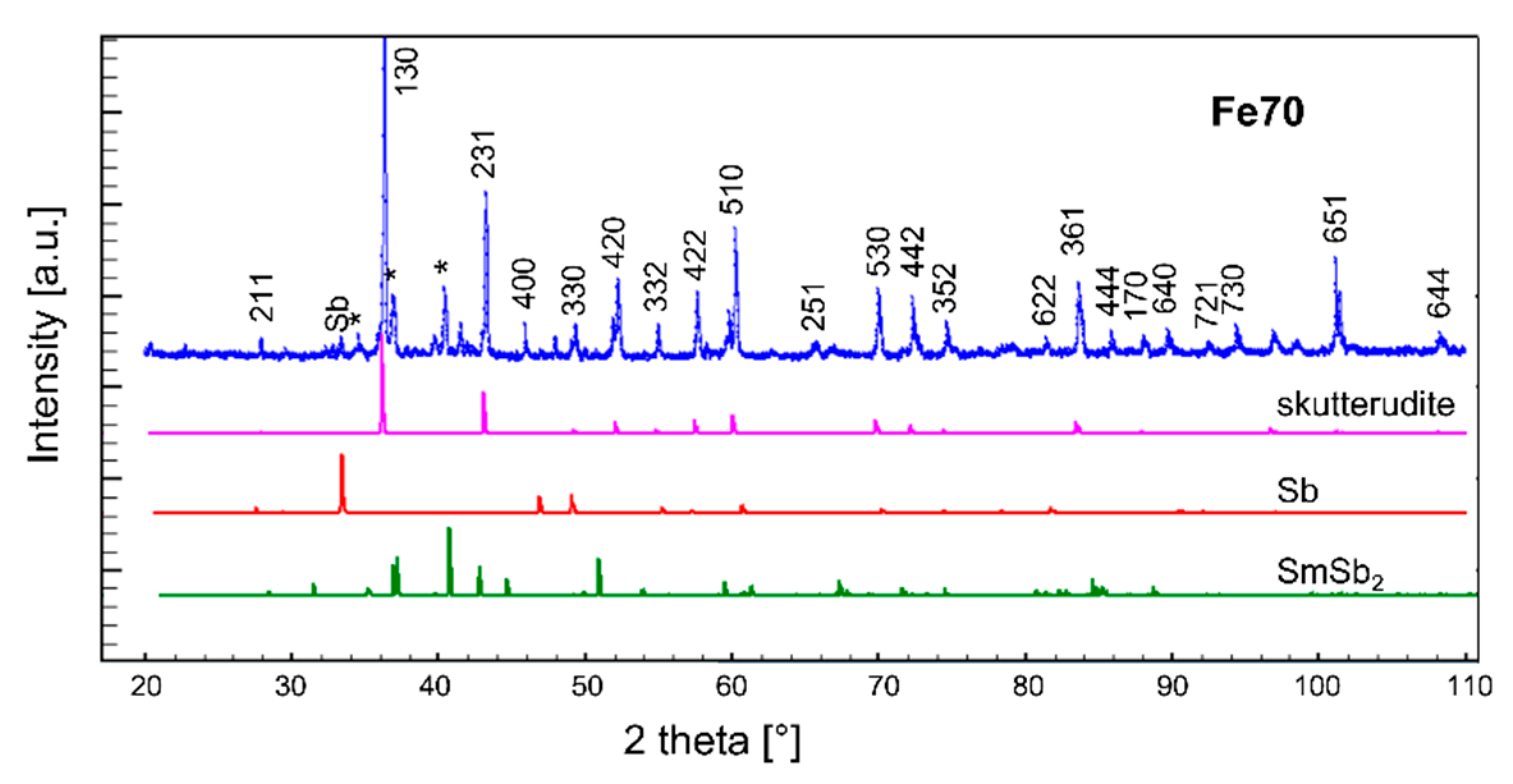
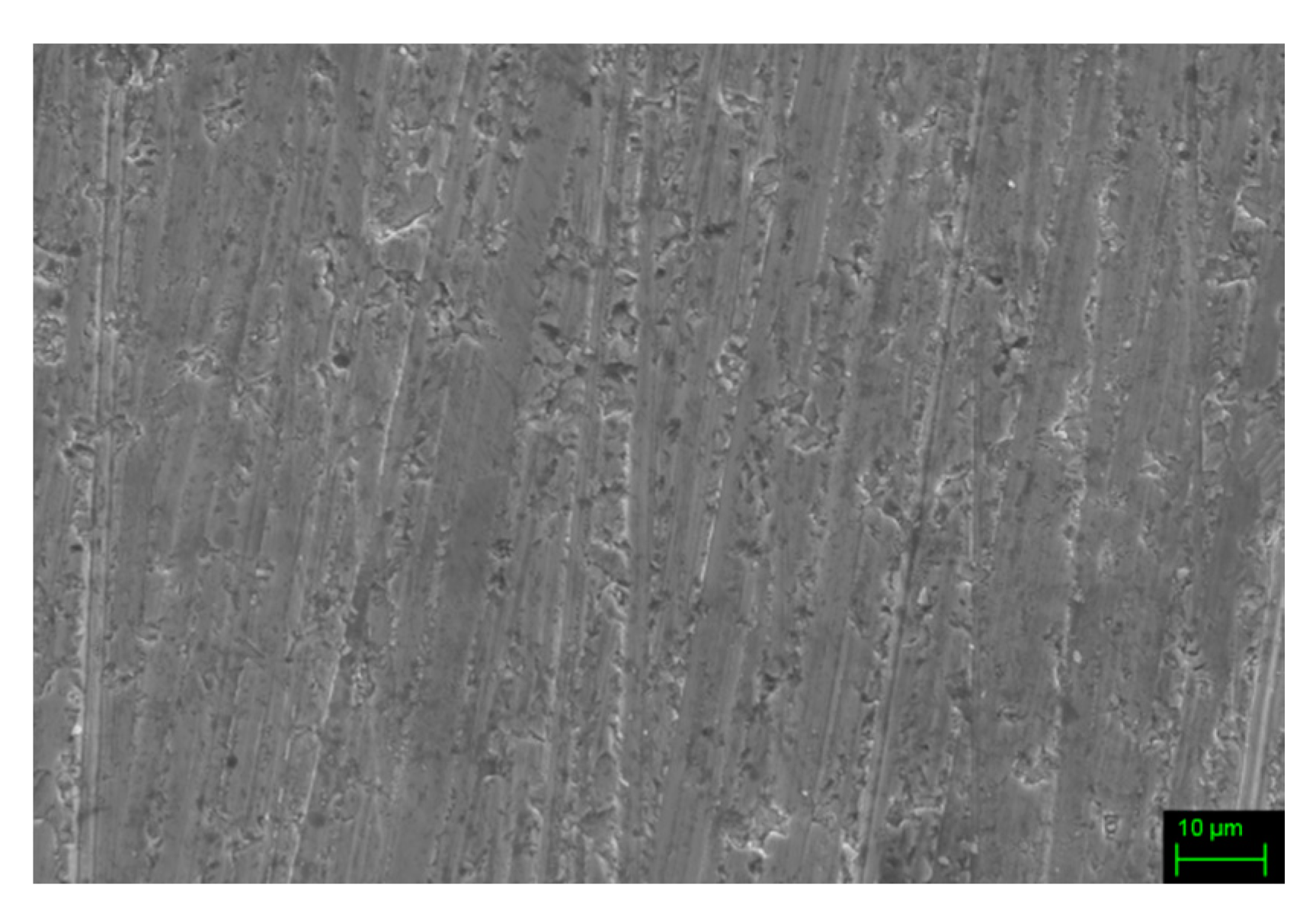

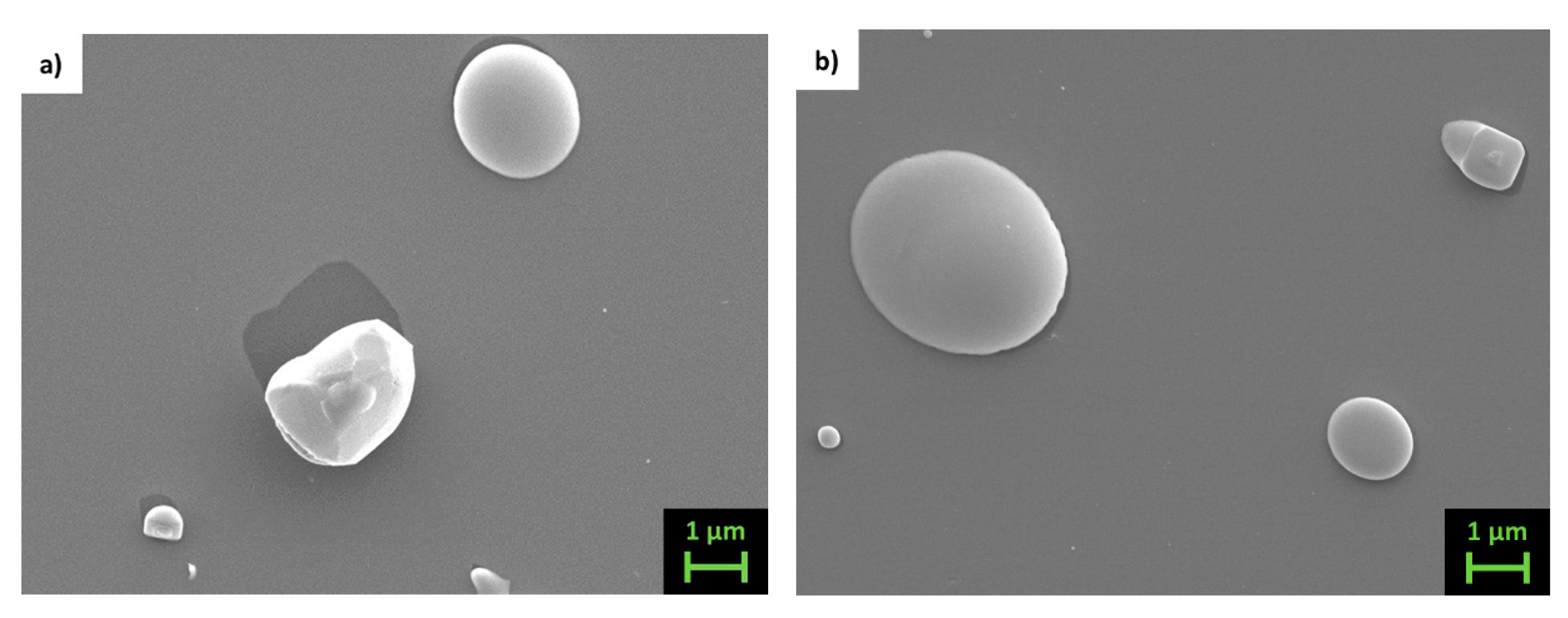


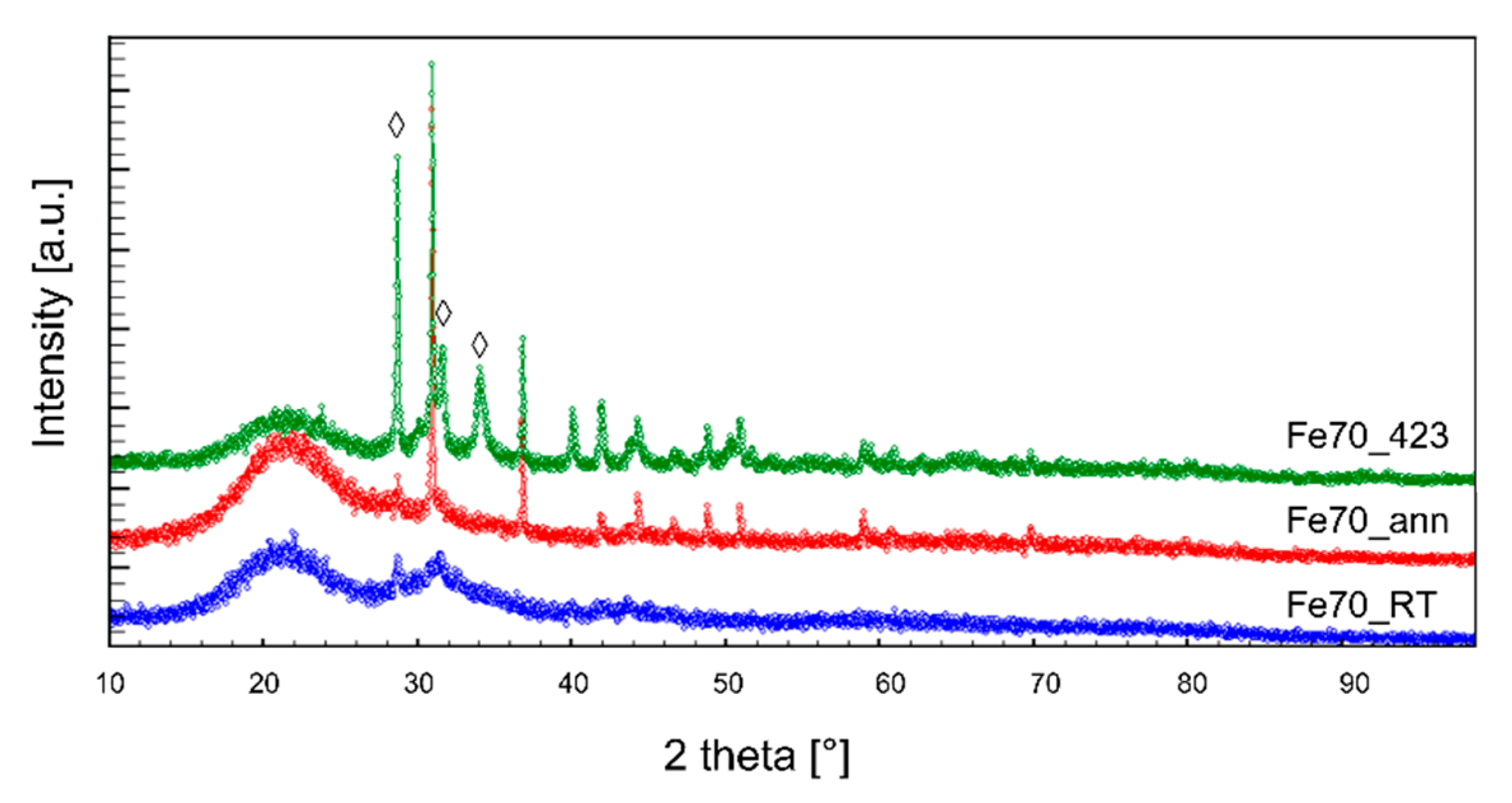


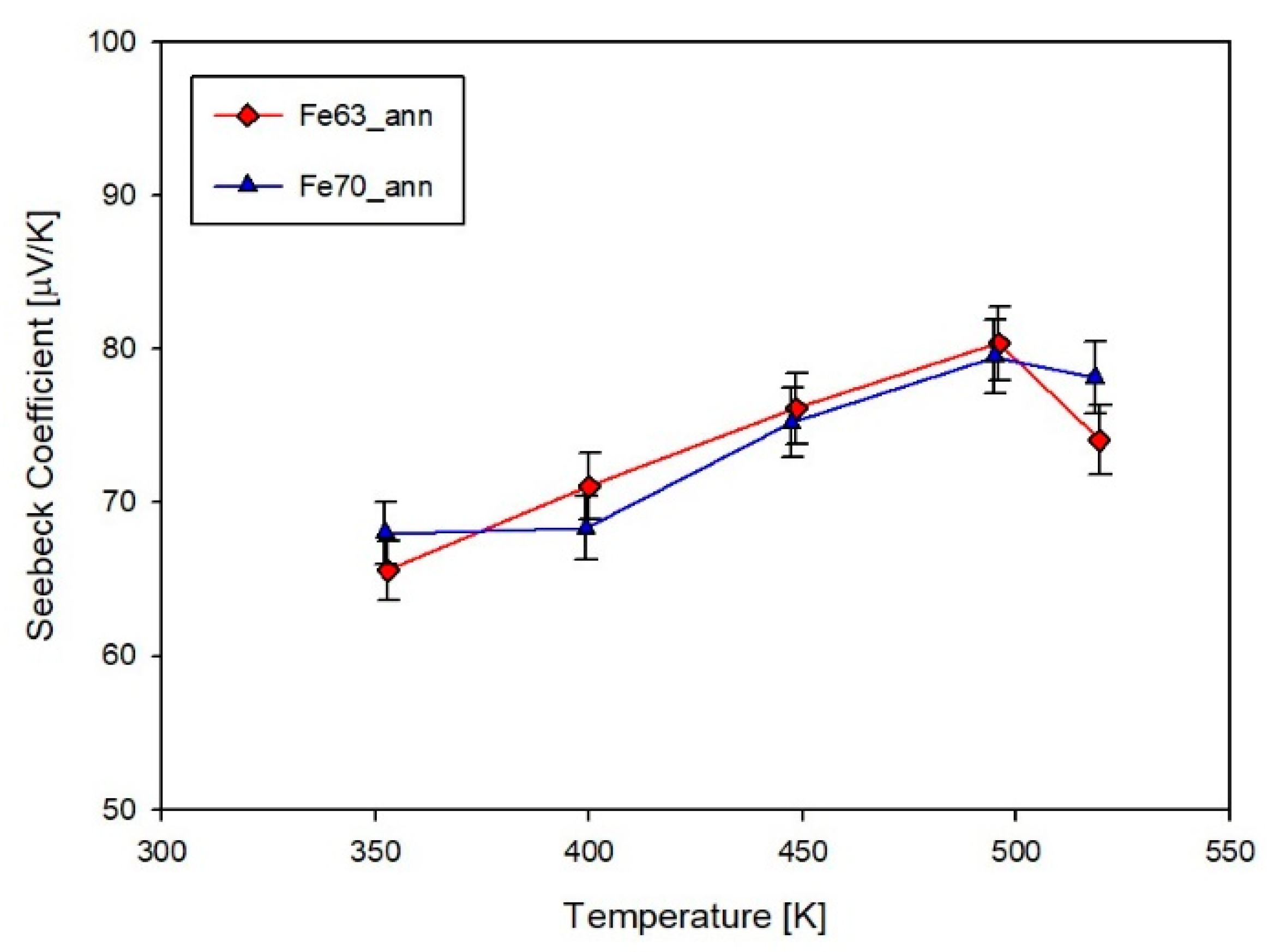
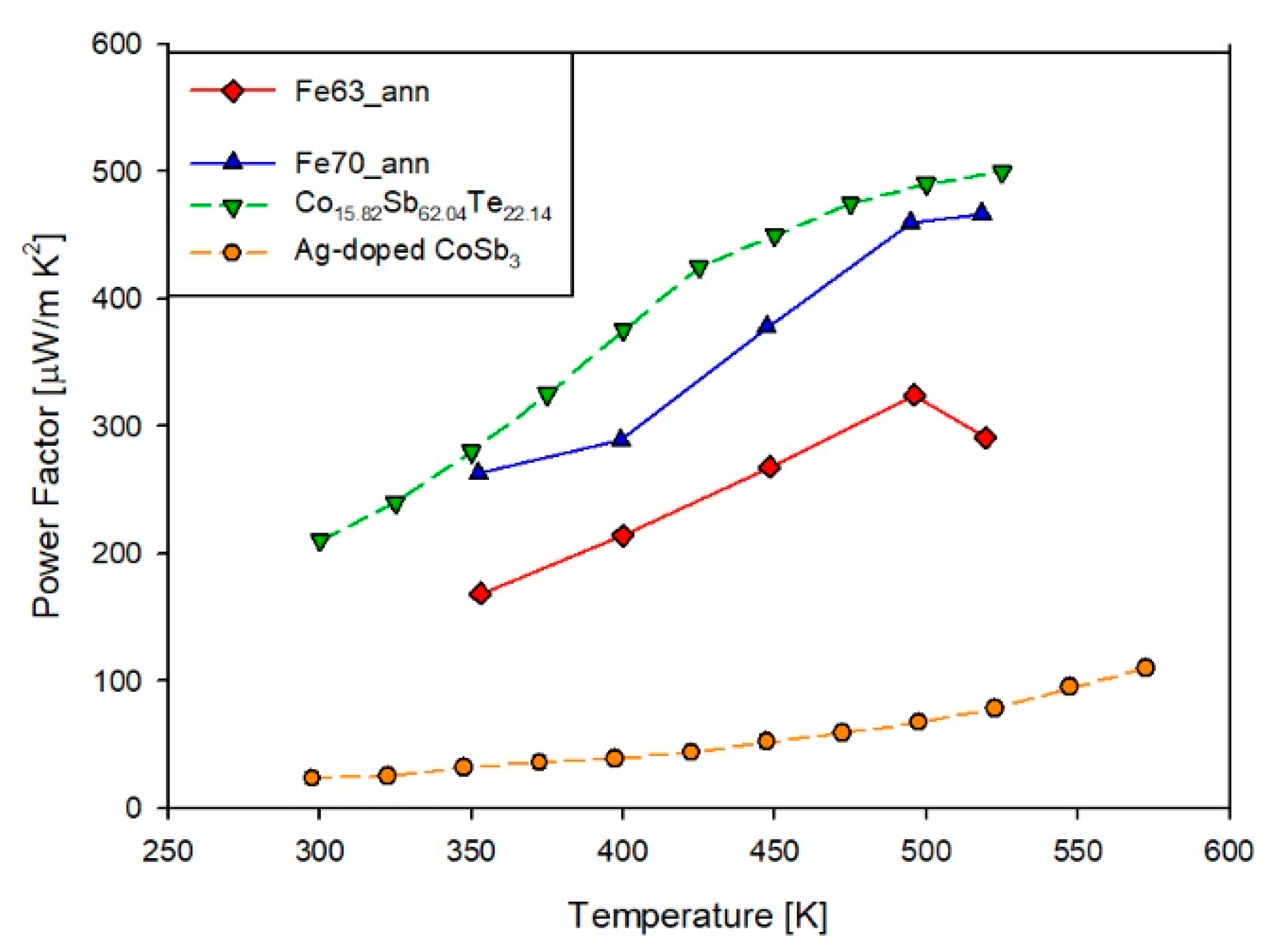
| Sample | Deposition Temperature [K] | Deposition Time [min] | Target–Substrate Distance [mm] | Annealing [min-K] |
|---|---|---|---|---|
| Fe63_RT | 293 | 60 | 35 | - |
| Fe63_423 | 423 | 60 | 35 | - |
| Fe63_ann | 293 | 60 | 35 | 60–423 |
| Fe70_RT | 293 | 60 | 35 | - |
| Fe70_423 | 423 | 60 | 35 | - |
| Fe70_ann | 293 | 60 | 35 | 60–423 |
| Sample | Thickness [nm] | S @ RT [μV/K] | S @ 523K [μV/K] | [W/m·K] |
|---|---|---|---|---|
| Fe63_RT | 490 | 71.6 | 72.7 | - |
| Fe63_ann | 300 | 65.6 | 74.1 | 1.91 |
| Fe70_RT | 520 | 1.30 | 3.68 | - |
| Fe70_ann | 200 | 68.0 | 78.2 | 2.21 |
Publisher’s Note: MDPI stays neutral with regard to jurisdictional claims in published maps and institutional affiliations. |
© 2021 by the authors. Licensee MDPI, Basel, Switzerland. This article is an open access article distributed under the terms and conditions of the Creative Commons Attribution (CC BY) license (https://creativecommons.org/licenses/by/4.0/).
Share and Cite
Latronico, G.; Mele, P.; Artini, C.; Manfrinetti, P.; Pan, S.W.; Kawamura, Y.; Sekine, C.; Singh, S.; Takeuchi, T.; Baba, T.; et al. Investigation on the Power Factor of Skutterudite Smy(FexNi1−x)4Sb12 Thin Films: Effects of Deposition and Annealing Temperature. Materials 2021, 14, 5773. https://doi.org/10.3390/ma14195773
Latronico G, Mele P, Artini C, Manfrinetti P, Pan SW, Kawamura Y, Sekine C, Singh S, Takeuchi T, Baba T, et al. Investigation on the Power Factor of Skutterudite Smy(FexNi1−x)4Sb12 Thin Films: Effects of Deposition and Annealing Temperature. Materials. 2021; 14(19):5773. https://doi.org/10.3390/ma14195773
Chicago/Turabian StyleLatronico, Giovanna, Paolo Mele, Cristina Artini, Pietro Manfrinetti, Sian Wei Pan, Yukihiro Kawamura, Chihiro Sekine, Saurabh Singh, Tsunehiro Takeuchi, Takahiro Baba, and et al. 2021. "Investigation on the Power Factor of Skutterudite Smy(FexNi1−x)4Sb12 Thin Films: Effects of Deposition and Annealing Temperature" Materials 14, no. 19: 5773. https://doi.org/10.3390/ma14195773








